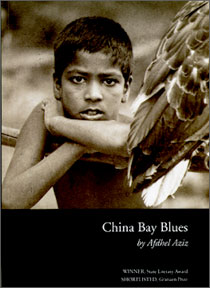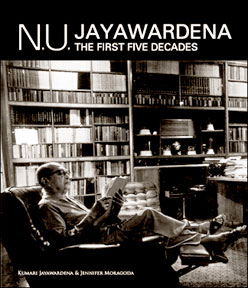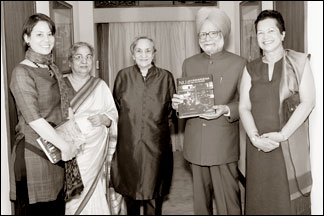|

Experiment with language
Rewiewed by Sajitha Prematunge
I am no expert at photography. So am more than glad to leave out my
criticisms or praise about the photographs included in the book. However
I can vouch for the poetic expertise of the poet and the economy of the
writer in the prose.
 Inclusive of two sections of poetry - Noon Shadows, Secrete Gardens
and a section contain two short stories, no two works are the same, save
perhaps for one or two love poems. It’s the only book - that I have come
across - which accommodates two genres and an appropriate combination of
a completely different form of art, that is photography. Inclusive of two sections of poetry - Noon Shadows, Secrete Gardens
and a section contain two short stories, no two works are the same, save
perhaps for one or two love poems. It’s the only book - that I have come
across - which accommodates two genres and an appropriate combination of
a completely different form of art, that is photography.
The poetry and prose of China Bay Blues deal with themes like love,
war, violence, death, living in exile and other more mundane themes. The
poem 1983 deals with the theme of war and violence. But it does not
directly make use of the gruesome imagery of Black July at the
beginning. The manner and tone in which the poem begins
‘There is great sadness
in this July night....’
is an understatement. Although no two poems could be more different,
he produces something like cinematic montage in both 1983 and
Trincomalee Road skipping from one scene to the next without difficulty,
he does so in the case of 1983, probably to throw light on the
ruthlessness of the riots, to provide as many snapshots of the violence
as economically as possible. Of course in Trincomalee Road he uses the
images to give the impression of variety encountered during a drive on
Trincomalee road. However in this poem the poet tends to romanticise Sri
Lanka, which most expatriates are guilty of.
Earth worm tango is an ironic and sarcastic poem that deal with the
theme of death. In this poem Afdhel Aziz attempts to shed light on the
impractical and useless rites and rituals that a funeral entails.
‘Where pious men praise you to
the skies with their honest lies’
The lines suggests the poets boldness of sarcasm.
Meditation in Chelsea is about living in exile, an expatriate,
nostalgically reminiscing the land he left behind, looking at the post
card fastened to the mirror. Old love explores this same theme of
nostalgia.
Afdhel Aziz seems to make his poems intensely personal, to the last
minute detail. If they are not born out of experience, then he is indeed
very creative.
In Patriot - an ironic title in itself -the guilt of a man who would
probably not go to the extent of sacrificing his life for the country if
circumstances called for it, is realistically portrayed.
Aziz gets his subject matter and themes from mundane occurrences.
Untitled (care free and sunburnt); - there is quite a few untitled poems
in the collection - Skinsweat; Charlie Parker and Miles Away, which are
about saxophone players, are some such examples.
Aziz’s knowledge in music is displayed by the manner he vividly
describes the sax players actions and the technical jargon he uses in
the poem. He peppers the poems with colloquial and jazz language - such
used by musicians - enhancing its realism.
‘blue note heaven, baby’
Formlessness and lack of rhyme is characteristic of China Bay Blues
except for the lyrical love poems. The poet simply refuses to conform to
the generally accepted norms of poetic form, creating his own version of
form through experimenting with language and structure.
He experiments without restraint, while also using different tones
and jargon for different subject matter. Radio Song is another
successful attempt to experiment with language. It is an intriguing poem
where an interesting parallel is drawn between a poem and a radio song.
The language he uses in this particular poem is colloquial, peppered
with slang, pauses perfectly placed, making it, indeed, sound like a
song. Although, I personally am not too fond of formless poems, I felt
that Ella sings deserved my full attention although there wasn’t much to
pay attention to.
He not only experiments with language, but also plays with the
concentration of the reader, when he breaks the flow of a poem with a
lone line like ‘salt water kisses taste so sweet’ or a curt word like
‘slow’.
A flaw in the collection is the lack of poems that deal with the true
Sri Lankan culture, in depth. The poems in the collection are mostly
introvert, probably born out of personal emotions and impulses.
They depict an international culture and romanticises the local. But
this may just be a result of the poets extensive travels and not due to
his lack of familiarity with local culture. America to a patriot may
seem ‘unpatriotic’
‘I knelt and puckered up on the tarmac’
But at leat the poet was bold enough to admit his allegiance. He is
not pretentious and does not attempt to include poems for the sake of
‘cultural justification’.China Bay Blues is most prominent for its
lyrical love poetry.
In fact a greater space of the collection is allocated for ‘Secret
Gardens’, the section that contain the lyrical love poems. Rather than
separate poems they seem to behave as an interconnection of poems.
There is almost no indication that Safecracker and Bloom are two
different poems except for the titles that separate them. The poems
explore the twists and turns, the bums and rough patches as well as rosy
side of a relationship. They depict how a relationship metamorphoses
from the honeymoon stage to disillusionment.
At times the poet describes the rough patches with a hint of sadness
and melancholy, as in Careless Orbit. At others it is a sort of
sentimental love.
He promises the lover the moon and the sun (Surf song). He describes
- at the risk of sounding like a cliche - how ‘two become one’. He
repeatedly recalls the image of the sleeping lover. In fact the romantic
in him seems to be obsessed with watching the sleeping lover, which he
alludes to, in many poems.
Although it seems sentimental, the sentimentality is impressive
coming from a man. He uses most unusual metaphors in Full moon fox like
‘bee’s knees’, ‘cream on the cat’s’ whiskers and ‘hieroglyphics on my
pyramid’, for his lover.
This is obviously a man in his honeymoon stage of the
relationship!But even the love poems are not totally melodramatic. Aziz
is one of the more bold poets. Whether it is because he is an expatriate
or not, he - without restraint - explores avenues normally tabooed by
Sri Lankan culture.
Tattoo, which refers to a guys one night stand, is one such example.
It’s also one of the more sensuous poems included in the collection.
However the language he uses is highly cryptic.
‘I want to make your
rigging creak in the wind....’
and ends it with
‘That’s how I love you baby
so let’s get down to business
time’s a wasting....’
Talk about blunt!
Desire is one of the most blatantly erotic poem I have come across
yet. An embarrassed, sly smirk-across-the-face is guaranteed for any one
who want to test their tolerance to such a downright expressive form of
art. In this poem he describes ‘desire’ in many ways.
‘Desire is....
a moment’s succumbing
a lifetime’s atonement.’
Without quoting extensively I will let the reader be the judge.While
he also romanticises ‘love’, he is not completely oblivious to the
bleaker side of it, he also focuses on the rough patches and doubts. He
draws unusual parallels between the lover and fire/devil, thoroughbred
and humming bird.
It is indeed very rare for a literary personality to become equally
competent in poetry as well as prose. Although there are only two short
stories in the collection, they depict a high level of creativity.
As fiction alone the stories doesn’t amount to much, specially since
they are so short. But the writer seems, yet again, not very keen on
sticking to standard norms. Rather than the fictional value of the
story, Aziz focuses on the moral message - the theme of the story. The
house in the corner is a short story in the literal sense.
In fact it is doubtful whether it qualifies as a story at all. It’s
just a narrative an essay, made so undoubtedly purposely by the writer.
The whole of the story is set within a house. However through a cascade
of simple events he approaches a major theme - violence. But until the
very end the readers are oblivious to it.
The story takes its time describing the visits of the
bothal-paththerey, bombay mottai, and dhobi man and abruptly diverts the
plot to the insurgency. It describes how the lives of the people around
the house was shattered and the amount of violence the house witnessed.
The only other story of the whole collection although very similar in
style to the first, is completely different in tone. The tone of
Happiness is nonchalant and detached. There is only one developed
character, no dialogue, just a narrative.
The face cream the protagonist applies to stop himself from aging is
said to smell ‘reassuringly scientific’, he believes that he can remain
forever young by applying the face cream. In this story he rebukes the
isolated way of life of citizens of developed countries or city
dwellers.
For the lack of conventional poems that depict Sri Lankan culture,
China Bay is still a great read, partly for the experiments attempted
with language and poetic form and partly for prose that are not
judgemental and leaves the reader something to think about.
Book News:
Biography of N.U. Jayawardena Presented to Indian Prime Minister

|

Indian Prime Minister Dr. Manmohan Singh (second from right)
holding a copy of the book, N. U. Jayawardena - The First Five
Decades which was presented to him by the authors, Kumari
Jayawardena(third from right) Jennifer Moragoda (extreme left),
and Nelia Perera.(extreme right) Mrs. Gurshran Kaur ,Indian
Prime Minister’s wife is also in the picture. (Pix by : Sujeewa
Jayakody) |
The first copy of the biography,’ N. U. Jayawardena - The First Five
Decades’ was presented to Indian Prime Minister Dr. Manmohan Singh when
he visited Colombo for the 15th SAARC Summit. Prime Minister Singh first
met N. U. Jayawardena in the early 1950s, when the Prime Minister was a
student of Economics at Cambridge University with NU’s eldest son Lal.
The authors of the book, Kumari Jayawardena (NU’s daughter-in-law)
and Jennifer Moragoda (his granddaughter-in-law); the wife of the Prime
Minister, Gurshran Kaur; and other members of the Jayawardena family
were also present.
The biography examines the formative experiences in N. U.
Jayawardena’s early life and career, and the role he played, behind the
scenes, in shaping some of Sri Lanka’s key financial and economic
infrastructure.
His life is set against the backdrop of the political, economic and
social upheavals of the first half of the 20th century, such as the
Great Depression of the 1930s, the Second World War, and the period of
Sri Lanka’s transition into an independent nation.
The biography was published to mark Deshamanya N. U. Jayawardena’s
birth centenary (1908-2008). Jayawardena who lived until the age of 94,
and who started his career as a Government clerk, rose to become the
first Sri Lankan Governor of the Central Bank, and later served as a
Senator.
He spent the second half of his career in the private sector as a
leading banker, financier and businessman. The book will be available in
early September in leading bookstores. All proceeds from the sale of the
book will be donated to the N. U. Jayawardena Charitable Trust.
Unique gift
Gift of the Dhamma is a collection of Dhamma talks made by Venerable
Panditha Horana Pannasekera Maha Thero during his 20 year stay at the
Thames Buddhist Vihara, London as the religious director. It is edited
by Dr. Douglas Mulgirigama.
The book contains 32 dhamma discussions the thera made on varied
topics such as merits of worship, caring for parents, controlling
thoughts, responsibilities of parents, protection from evil spirits,
gradual path to the Dhamma, The first Nobble truth, The five aggregates,
ways of becoming virtuous, face fun and ridicule mindfully etc.
The thera has contributed immensely to the propagation of the Dhamma
throughout Europe. He had concerned mainly on the important task of
teaching the Dhamma, either collectively or individually. His
much-valued contribution to the spiritual needs and the general
wellbeing of everyone, has won him the hearts and minds of Buddhists and
non Buddhists alike.
The book has emerged as an attempt to record for the benefit of the
future generations, at least in small fraction of the wisdom the thera
shared with devotees who came to the temple to listen to him.
The talks reflect Ven. Pannasekera Thera’s in depth knowledge and his
ability to explain profound concepts in simple terms and show how they
could be incorporated into daily life.
New edition of ‘Kandy Esala Perahera’
Vijitha Yapa Publications has released the new edition of the Kandy
Esala Perahera, with beautiful photographs and descriptions ranging from
the history of the pageant to details of what happens before the
Perahera and the actual Perahera itself brought out in time for the
Perahera season.
Written with expertise by Professor Anuradha Seneviratne, the book
also contains some rare pictures while the centre spread shows the
Dalada Maligawa complex through a British artist’s eyes in 1819 in
contrast to a picture taken this year.
The Author who has very close links with the Sacred Temple of the
Tooth, the Dalada Maligawa, traces the evolution of the Kandy Esala
Perahera since its inception over 1,600 years ago during the reign of
King Kirti Sri Meghavarna (Kitsiri Mevan).
He refers to ancient texts, the Dalada Sirita, the Culavamsa, etc,
and other descriptions by Robert Knox, Davy, Millawa Disava, C.E.
Godakumbura, etc, complementing the text with supporting rare
photographs giving an insight into the rituals within the Dalada
Maligawa.
He makes the reader fully aware of the pageant of great aesthetic and
socio-cultural value in Ceylon (as this country was then called) held
annually in the lunar month of Esala (July/August).
The striking photographs are provided by the Diyawadana Nilame, the
author and Vijitha and Lalana Yapa. Dr. Anuradha Seneviratna was the
Senior Professor of Sinhala Faculty of the Peradeniya University and was
conferred the National Award ‘Kalakirti’ by the Government of Sri Lanka.
He has written nearly seventy books in Sinhala and English, and won
the State Literary Award thrice and was also the President of the Arts
Council of Sri Lanka. |
